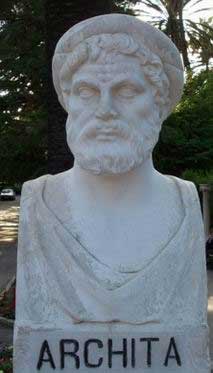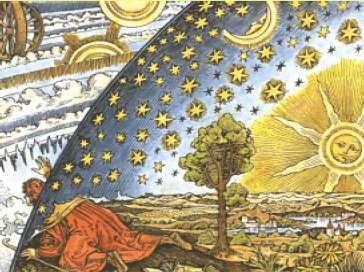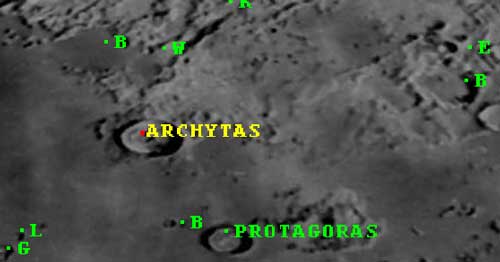.
Archytas und das unendliche Universum
invented "the most compelling argument ever produced for the infinity of space" Richard Sorabji

Archytas (Αρχύτας ο Ταραντίνος) (428-350 BC) born in Tarent (or Taras or Tarentum) son of Hestiaeus, politician, mathematician and philosopher. He was a Pythagorean and student of Philolaus.
He was said to have saved the life of Plato who has been sentenced to death by Dionysios, the tyrant of Syracus. Archytas provided a solution for the Delian problem of doubling the cube. Mueller calls his solution “a tour de force of the spatial imagination” (1997). Besides tutoring Eudoxos, some historians assume that Archytas also tutored Plato in mathematics point during the ten years that Plato spent in Sicily and Southern Italy.
Archytas believed that the universe is infinite, has no limits. Assume he said that the universe is finite and I am at one border of the universe. What hinders me to stretch my hand beyond this limit? (Simplicius 467,26) What is behind these limits (see Image above)? It is not clear why Plato and Aristotle have not accepted this argument but probably because they had some problems accepting the existence of a body without boundaries and the infinite in general.

The Flammarion Woodcut
Aristotle thought that the stars were spheres at a range of distances from the Earth. In medieval times stars were considered as holes in the surface of a sphere that let through light from behind. The flat-earth woodcut as visual rhetoric I use it here as an explanation of Archytas “Gedankenexperiment”. Archytas stretching his hand at a border of the universe.
A similar idea had Euclid in his proof of the infinite number of primes. The idea of Euclid is to add 1 to the product of all assumed limited number of primes showing then that this number is either itself prime or a prime number exists that is larger than the largest prime used in the product.
Other adopted also supported the idea of a infinite Universe such as Democritus and Epicurus with similar arguments.
And so I'll follow on, and whereso'er thou set the extreme coasts, I'll query, "what becomes thereafter of thy spear?" 'Twill come to pass that nowhere can a world's-end be, and that the chance for further ight prolongs forever the flight itself. Lucretius (98?-55? BC), De Rerum Natura
Is it possible that a “Euclidean” universe has limits? For a non-euclidean geometry this is possible. Consider that you leave on the surface of a sphere but you do not know this. Moving straight forward on the sphere we will sometime reach the same point where we started. We can move forever and stretch our hand always but we know that the sphere is limited. Therefore it is possible that the universe is also limited.
Astronomers believe that we are close to answer the question that was considered by the ancient Greeks, whether the Universe is finite or infinite. They believe that measurements among others of the cosmic background radiation will provide soon a final answer.
Archytas and the pigeon
...but sound authority holds that Archytas of Tarentum experimented with kites and toy flying machines, including a wooden dove that flew by "the secret blowing of air enclosed inside," perhaps a primitive compressed-air mechanism. The pigeon in one of the experiments was able to fly 200 meters! Archytas of Tarentum was a Greek mathematician, political leader and philosopher, active in the first half of the fourth century BC (i.e., during Plato's lifetime).
The only mechanical device that can with some probability be assigned to Archytas, apart from the children's toy known as a “clapper” is an automaton in the form of a wooden bird connected to a pulley and counterweight, which “flew” up from a lower perch to a higher one, when set in motion by a puff of air. The complicating factor here is that Diogenes Laertius reports that there was a book on mechanics in circulation, which some thought to be by a different Archytas, so that it is possible that the flying dove is, in fact, the work of a separate Archytas.
References
Aulius Gellius, Noctes Atticae, X 12,9
Mueller, I., 1997, ‘Greek arithmetic, geometry and harmonics: Thales to Plato’, in Routledge History of Philosophy Vol. I: From the Beginning to Plato, C. C. W. Taylor (ed.), London: Routledge
Richard Sorabji, Matter, Space and Motion, Ithaca: Cornell University Press, 1988
Archytas’s Musical Construction (and the Conics) by Fletcher James
| Ancient Greece
Science, Technology , Medicine , Warfare, , Biographies , Life , Cities/Places/Maps , Arts , Literature , Philosophy ,Olympics, Mythology , History , Images Medieval Greece / Byzantine Empire Science, Technology, Arts, , Warfare , Literature, Biographies, Icons, History Modern Greece Cities, Islands, Regions, Fauna/Flora ,Biographies , History , Warfare, Science/Technology, Literature, Music , Arts , Film/Actors , Sport , Fashion --- |



